Once your island was a Caribbean paradise. There used to be plenty of room for the different tribes that shared it. Sadly, the island has become overpopulated and the once-friendly tribes are now hostile toward each other. The tribes are on the brink of war, and all are counting on the magic powers of their shaman to help them defeat their enemies and claim the largest portions of land.
Components
The following piecepack components are needed to play Shaman Island:
- 5 tiles (landmasses) for each player
- One token (shaman) per player
- One set of coins (warriors) per player
- One die (player color indicator and spirit marker) per player
Object
Earn the most points by controlling more island territory than your opponents. An island is controlled by the player who has the most total warrior points (coin values) there.
Setup
Place one tile in the center of the playing area, grid-side up. This tile is the first part of the island.
Beginning with a randomly-determined starting player, each player takes a turn adding a tile to the island. Each player must place their first three tiles directly on the table with at least half of one edge touching an already-placed tile. Each players' last two tiles must be placed squarely on top of one other tile already in the island.
After all land tiles are placed, players continue taking turns to place their playing pieces. First shamans are placed, then each of the warriors are placed in any order.
Note: Players may check the value of any of their warriors at any time during the game.
Gameplay
On each turn, a player must perform two of the following actions (either two different actions or the same action twice, with some restrictions):
- Move a warrior (coin) or shaman (token)
- Exchange positions of a shaman and a warrior through spirit movement
- Sink a land tile
- Move a land tile
Move a warrior or shaman
Warriors move as far as desired orthagonally (like a chess rook). Shamans move as far as desired orthagonally and diagonally (like a chess queen). Different levels of land do not effect warrior or shaman movement in any way. They may move over friendly warriors and shamans, but not over enemy warriors or shamans. They must land on an empty space and may not move over water (except when a shaman uses spirit movement, as described below).
Spirit movement
Using spirit movement, shaman may exchange places with any warrior in the same tribe. This action takes two separate player turns to complete.
- Remove the shaman from the board and replace it with the die of the same color, which represents the shaman's spirit.
- Place the shaman on top of the warrior that he wishes to trade places with. Note: If this is done as the first action of the turn, the shaman and the target warrior cannot be moved as the second action. In addition, since the shaman currently only exists in the spirit world, no moving or sinking of landmasses may occur as a second action.
- Before any actions are performed on the player's next turn, the swap is completed by removing the warrior from under the shaman and placing it in the space with the die, removing the die from the board. Note: This does not count as one of the player's actions for the second turn.
Riding on a spirit
Since spirit movement takes two turns to complete, other players have an opportunity to "hitch a ride" on the spirit of the moving shaman. This is accomplished by using an action to move a warrior or shaman (following standard movement rules) onto the spirit (die) of the shaman who is using spirit movement. Any warrior or shaman can ride the spirit of any shaman, even an enemy.
Only one warrior or shaman may ride on a spirit. When the shaman completes his spirit movement, the riding warrior or shaman is moved to the shaman's destination space, and is placed on the nearest empty space of the shaman's choice.
Example:
Ethan has a shaman on island A and a warrior on island B. As his second action, Ethan decides to initiate spirit movement to swap the places of his warrior and shaman. He replaces the shaman with his die and places the shaman on top of the warrior. His turn is now over.
Samantha wants to take one of her warriors from island A to island B, and seizes the opportunity to ride on spirit of Ethan's shaman. As one of her actions, Samantha moves her warrior onto the die on island A.
On his next move, Ethan replaces the die on island A with the target warrior from island B. He also takes Samantha's warrior that was resting on the die and places it in the nearest empty space to the shaman's new position on island B. If there is more than one space equally near, Ethan places Samantha's warrior in the space of his choice.
Sinking a land tile
Shamans have mystical powers that enable them to alter the landscape. The simplest thing they can do is to sink a land tile. There are a few restrictions:
- The shaman must be present on the same island as the land tile.
- The land tile to be sunk must be at sea level (resting on the playing surface).
- There can be nothing resting on top of the tile. If a warrior, shaman, spirit, or other land tile is on it, the tile cannot be sunk.
If these restrictions are met, the tile can be sunk, removing it from the game.
Moving a land tile
A shaman can magically move land tiles on the island that they occupy. A full tile movement consists of two half-tile-width steps, making it move a total of one tile width. Land tiles at sea-level must slide along existing land tiles, and tiles above sea-level must slide into adjacent empty water (ending their movement at sea-level).
Examples:

The simplest example of moving a land tile. It simply slides along the edges of the other island tiles, ending one tile-width from where it started.
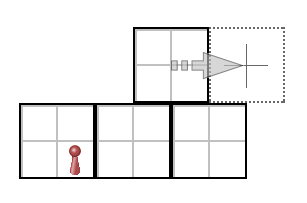
Sometimes a tile might end up hanging halfway into open water.
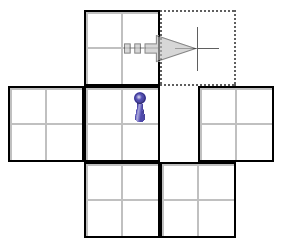
Gaps of a half-tile width are simply passed over.
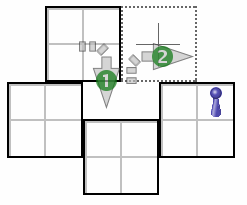
Gaps of a full tile-width or more may not be passed over, they must be followed. This tile slid around two corners, ending up on the other side of the indentation.
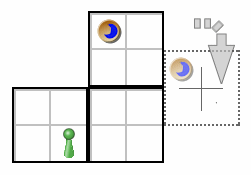
If the move takes it beyond the corner of another tile, it continues sliding (retaining its orientation) until half of its edge rejoins the rest of the island.
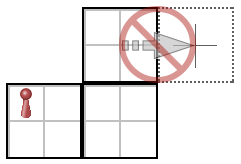
Tiles touching only at a corner are considered to be disconnected, and moving a land tile may not result in that single tile being disconnected, even at the halfway point of the movement. It must always retain at least a half-edge in contact with another tile.
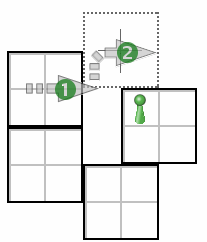
Here the tile slides straight across a half-width gap, then turns a corner.
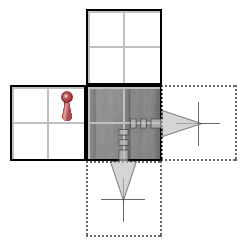
A land tile that is two or more levels above sea-level may slide straight off into adjacent empty water only. Tiles may not slide onto other tiles.
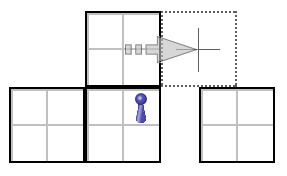
This is an example of how a tile might end up connected to a different island after moving. The single-tile island on the right is only a half tile-width away, so the moving tile crosses the gap.
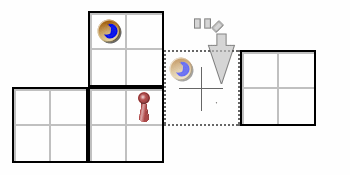
If the second island is a whole tile-width away, then the moving tile will end up between them, bridging the gap. The two islands are rejoined into one.
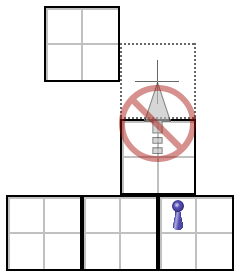
A tile cannot be pushed directly away from the rest of the island, even if there is another island to connect to.
During play, a land movement situation may arise that is not covered in these examples. In that case, use your best judgement. If players simply cannot agree, put it to a vote, flip a coin, or arm wrestle for it.
Ending the game
The game ends immediately when there is one more island than there are players in the game. I.e., five islands in a four player game, four islands in a three player game, etc.
If there is a shaman in the midst of spirit movement when the game ends, the shaman completes the movement before scoring occurs.
Scoring
Turn over all warriors and determine the total warrior value for each tribe on each island (blanks=zero, aces=one point, shamans=six points). The player with the most warrior points controls the island and receives victory points for it.
Victory points are determined by multiplying the number of tiles that make up the island by the value of the strongest warrior from the controlling tribe (shaman=six points).
If two or more players are tied for control of an island, they must share it. Divide the number of island tiles as evenly as possible, disregarding any remainder. Multiply the highest warrior value for each player by this divided tile count to determine victory points.
Examples:
Island A has four tiles. Brian has two warriors on the island, a two and a five, for a total of seven warrior points. Dave has a blank and a three, for a total of three warrior points. Brian wins the island and receives 20 victory points (four island tiles X a five-point warrior).
Island B has five tiles. Ben has his shaman on the island, for six points. Mark has three warriors, a one, a two, and a three. Both Ben and Mark have six warrior points, therefore the five tiles are divided between them, discarding one, giving each player two tiles. Ben receives 12 victory points (two tiles X six-point shaman), and Mark receives six victory points (two tiles X a three-point warrior).
The player with the most victory points wins the game.